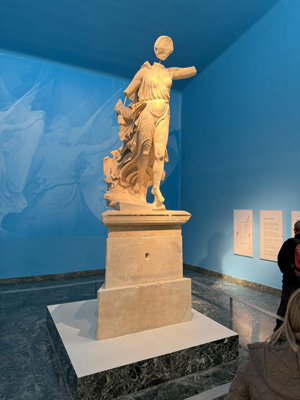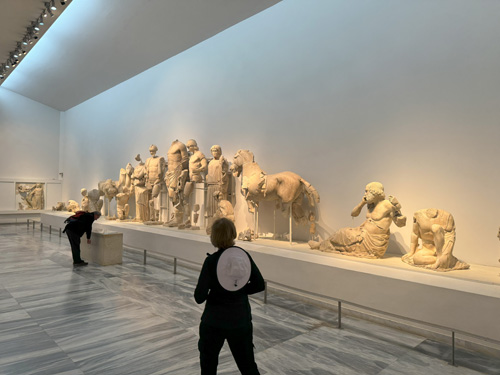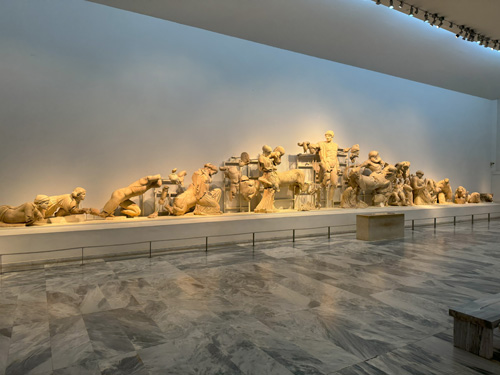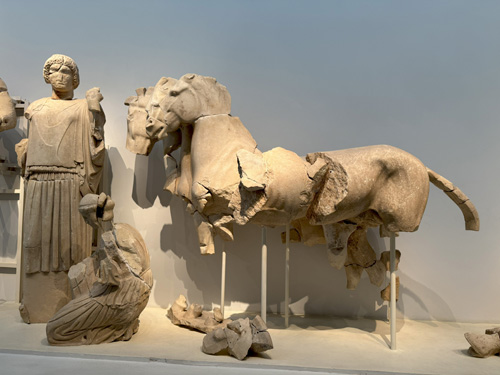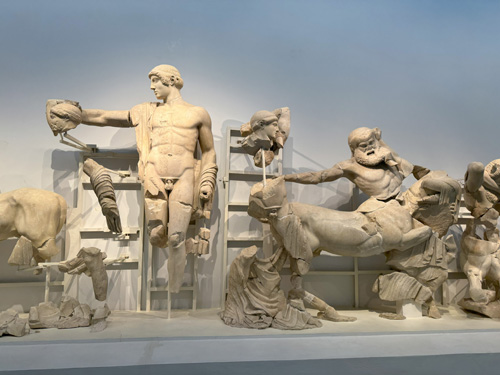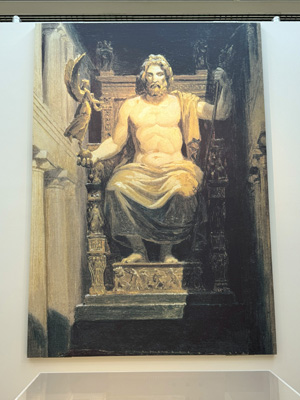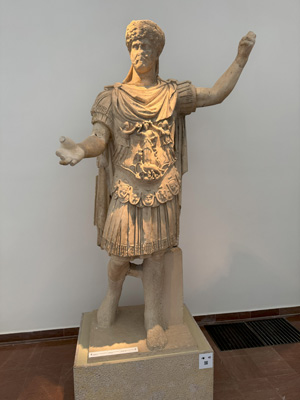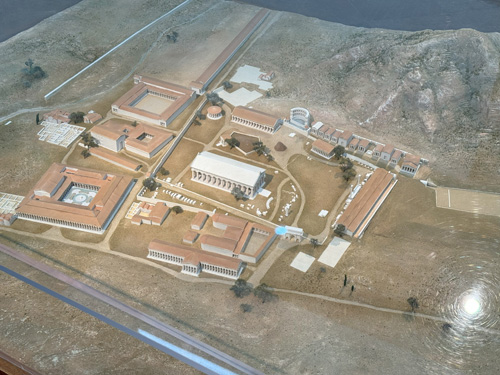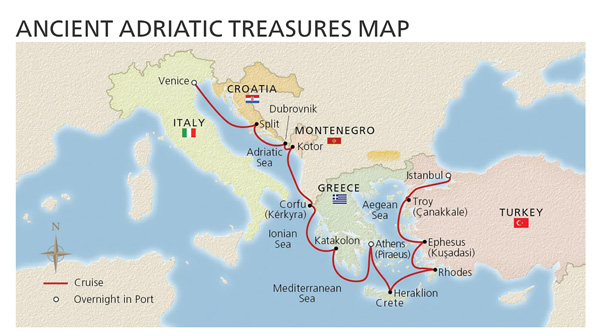Hal Jespersen’s Viking Mediterranean Cruise, May 2024
This my (Hal’s) report on Hal and Nancy’s brief visit to Rome and a 14-day Viking Mediterranean cruise from Venice to Istanbul, called “Ancient Adriatic Treasures.” Since this a long report, it is broken into two parts:
- Part 1: Rome and cruising from Venice to Olympia (this page)
- Part 2: Cruising from Athens to Istanbul
Wednesday–Thursday, April 17–18 — to Rome
We flew Lufthansa on a United ticket to Rome through Munich. Their Airbus 350 business class is not as comfortable as United’s 777, and a toddler screaming most of the night across the aisle didn’t help. Munich airport is very nice with lots of shops and restaurants. In Rome we booked the Boutique Hotel Campo dè Fiori; we are in a separate apartment building a few blocks away from the main (small) hotel, a two-story walkup to a nice, quiet room with a kitchen. Campo dè Fiori is a famous square that was known for public executions. There’s a statue of philosopher Giordano Bruno, who was burned to death here for his heliocentric views. Now he is surrounded by lively restaurants.
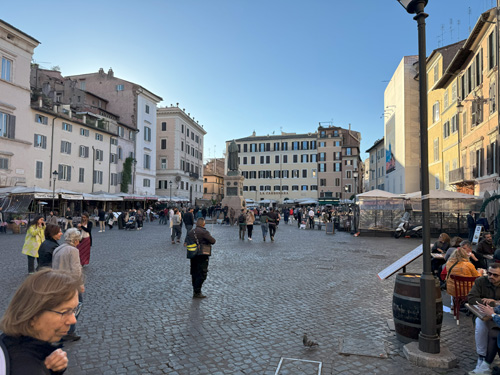

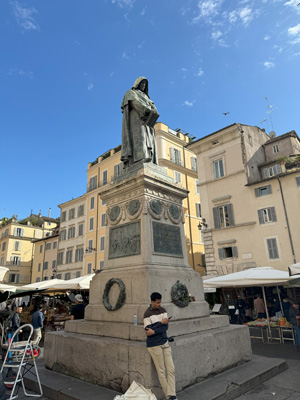
Friday, April 19 — Rome
Breakfast in a cafe on the Campo, which is entirely filled for the day with market stalls. We arranged a golf cart tour for the two of us through the hotel, which is an outstanding way to scoot around through lots of small alleyways for 4 hours, places buses can’t go. Cobblestone streets make for a slightly wild ride, reminiscent of a ride at Disneyland. Our driver/guide Matteo was excellent, very knowledgeable and personable. We saw too many buildings and sites to fully record here (as I forgot to bring my notebook), but some highlights:
- Castel Sant’Angelo
- St Peter's Basilica and Square in the Vatican
- Borgese Park and villa/museum, the latter closed but the famous Bernini statue Rape of Proserpina was visible through a rear window.
- a beautiful panoramic view of the city from the park
- the Spanish Steps and its adjacent luxury shopping area
- the Pantheon, the oldest Catholic Church in Rome, which has a spectacular interior underneath a giant dome, and its neighboring Fontana del Pantheon
- Quirinal Palace, built for a pope, with over 1000 rooms, but only one bathroom. It currently houses the president of Italy
- Via Rasella, where partisans attacked a German SS Police regiment in March 1944 killing 28 (which was followed by the Ardeatine Massacre of 352 Italians in retribution)
- Trevi Fountain, where the famous practice of throwing coins in the fountain was popularized by the American movie, Three Coins in the Fountain
- and lots of various government buildings
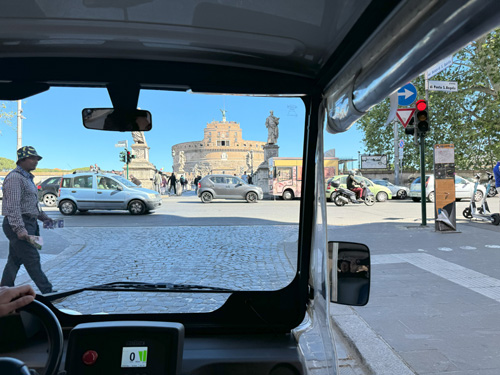
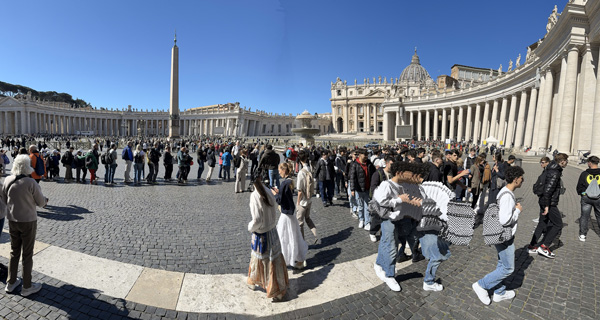
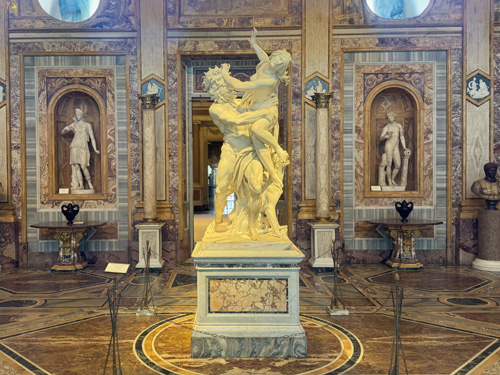

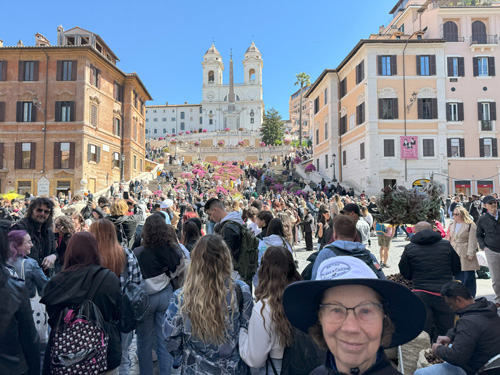
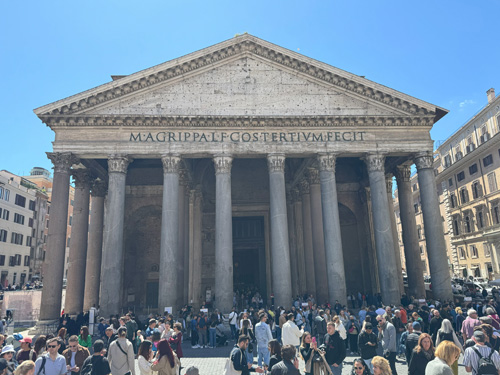
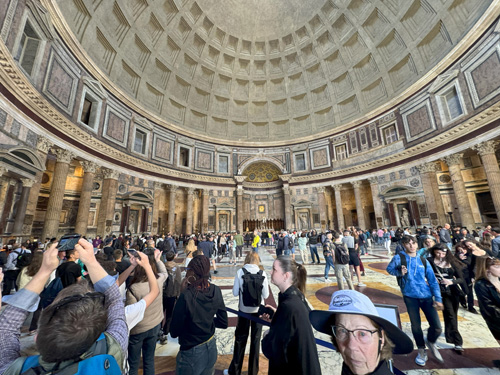
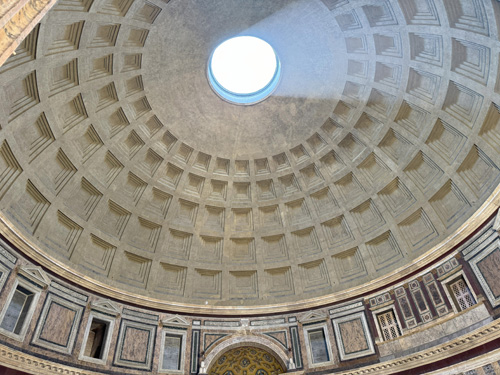
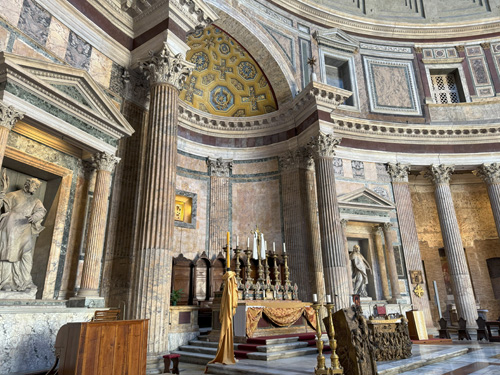
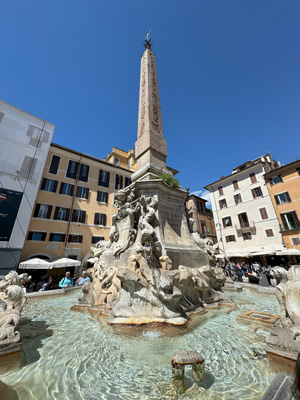
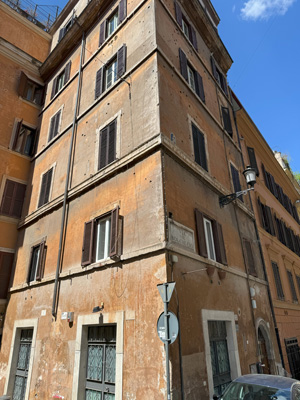
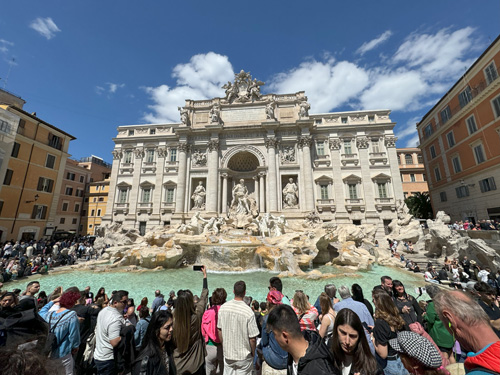
We avoided the Forum/Coliseum area because we told Matteo we’d be visiting there tomorrow. He dropped us off at an ophthalmic hospital in the Prati district, rather close to the Vatican, because Nancy had came down with a case of conjunctivitis, just like I had in France three weeks ago. It was a simple exam and antibiotics prescription, but we had to wait four hours to see a doctor. The good news is that the exam was free.
Matteo recommended a restaurant for Spaghetti Carbonara and it turned out to be four doors down from our apartment, Osteria da Fortuna. (Matteo told us that the word osteria originally meant a place where you brought your own food and they sold you the drinks, but today there is no distinction from restaurant.) We had Suppli (fried rice balls) as appetizers and then Carbonara and Cacio e Pepe, two of the classic Roman pasta dishes, and both were outstanding. Minutes after we arrived, dozens of people began lining up outside for a no-reservations table. We walked around the local area and came upon the ruins of the Curia Pompeii, meeting place of the Senate and the site of Julius Caesar’s assassination.
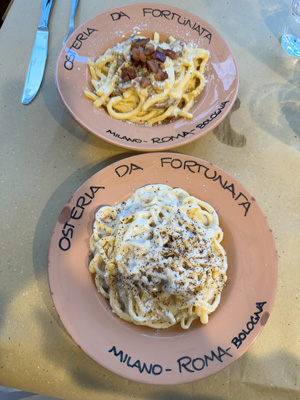
Saturday, April 20 — Rome
This morning we toured the Coliseum and Roman Forum for three hours. Our tour was meant for up to six people, but we were the only ones to sign up, so we had our guide to ourselves. Maria was a young historian who had an excellent grasp of the history of Rome and lots of architectural and construction details. We got in deep about the Coliseum, which had a remarkably varied history the last 2000 years (from 80 AD). I had toured here in 2022 (without Nancy), but today was much more comprehensive so it was well worth the repeat visit. We walked through the Forum and saw a number of ruined temples and official buildings, including where Caesar was cremated and declared a god (the practice of which is where we get the word apotheosis). Maria’s comments about how poorly Nero acted and how his 80-acre estate and reputation/history were obliterated (somewhat like the Stalin-era and 1984 practices) were particularly interesting. I won’t attempt to record all the details and sites and stories, but I took a few photos.
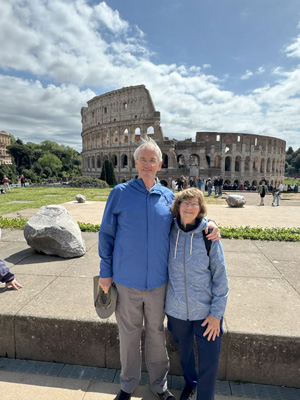
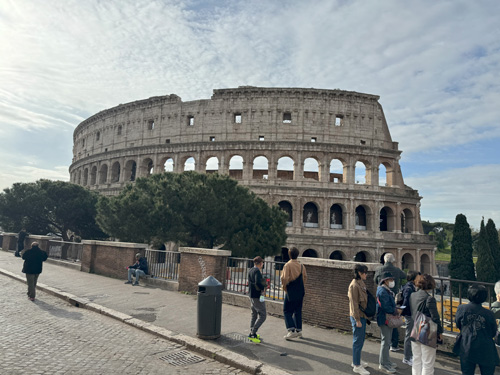
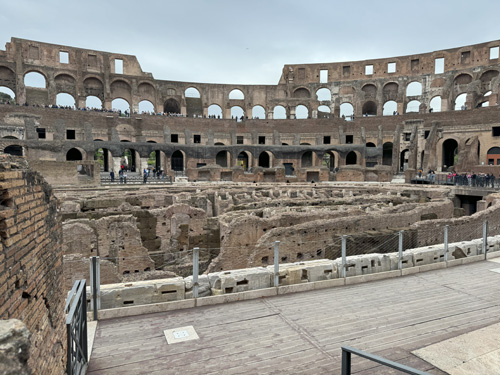
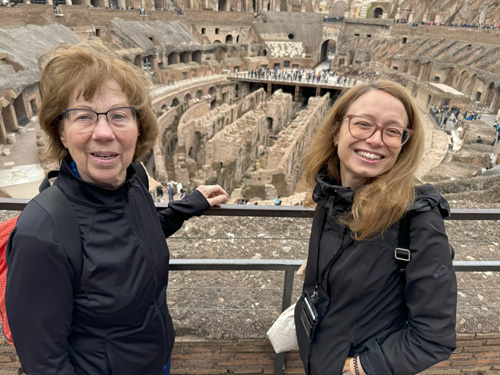
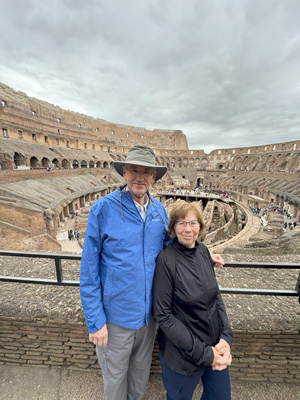

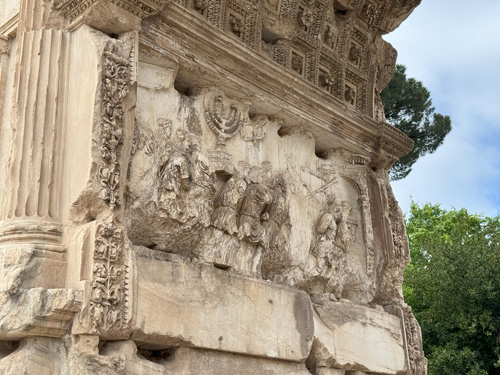
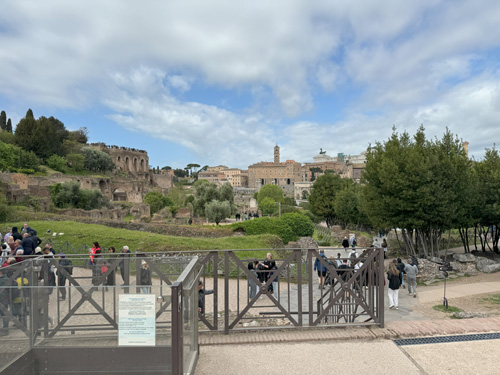
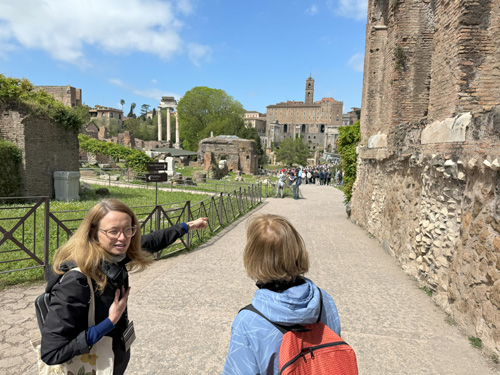
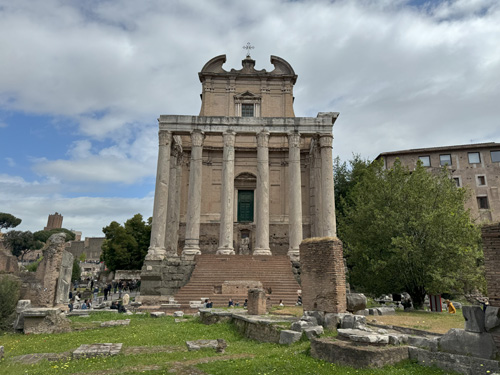
Maria recommended a small pizzeria where we ordered two varieties of square slices by weight (“al taglio”). We walked about a mile through super-crowded streets back to the hotel and stopped for a delicious gelato in Campo dè Fiori. After a rest-up break, we found a small museum a block away that had an interesting exhibition of Leonardo da Vinci inventions, 64 wooden models crafted from his detailed drawings. Some were simple devices like screws, cogs, and ball bearings, but also big things like impractical airplanes and helicopters, and even war machines like a primitive tank and a rotating, high rate of fire cannon system.
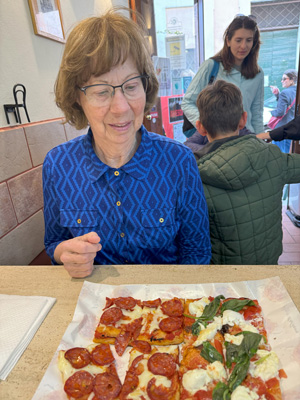
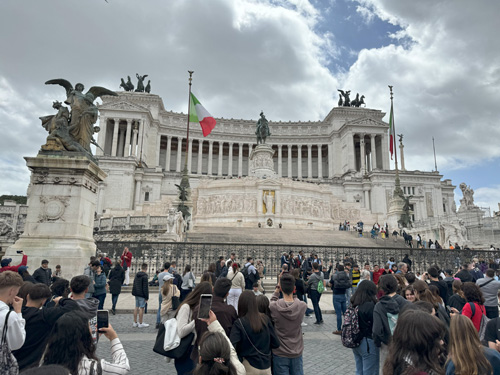
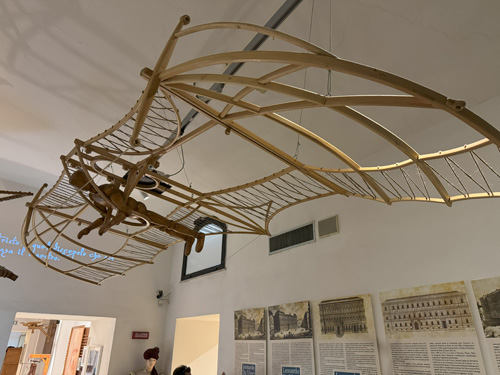
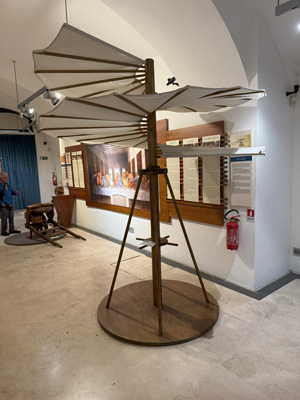
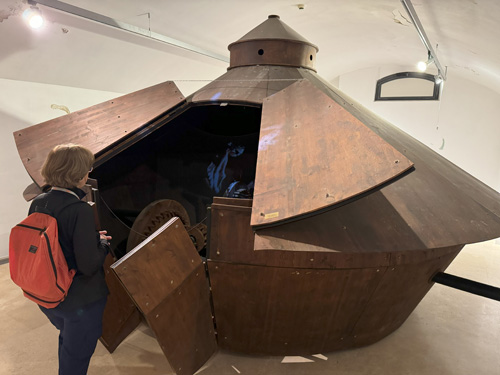
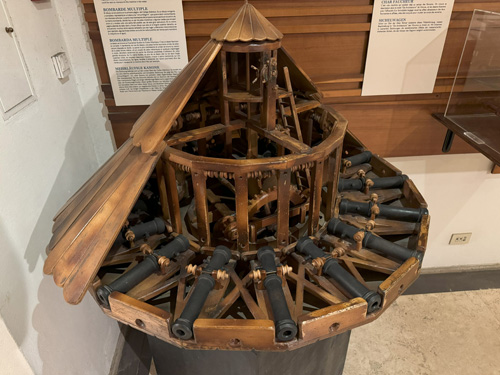
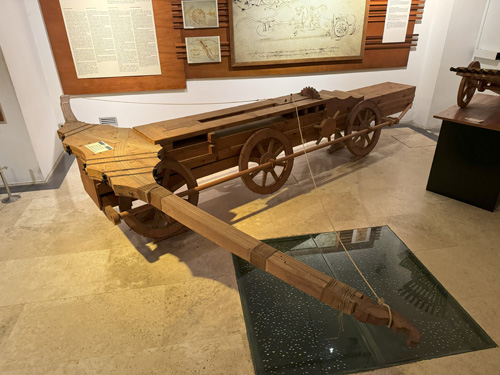
For the evening we returned to the Prati district for a foodie tour. I had taken essentially the same tour in 2022 and I thought Nancy would enjoy it too. It turns out that this evening version of the tour was substantially better than the mid-morning one I took then—more food, lots more very decent wines. Our guide was a beautiful young Argentinian woman nicknamed Lucy and we had seven guests, all American except for one Swiss. Highlights:
- La Nicchia Cafe. We had a sampler of three bruschette, a Parmigiana-Reggiano cheese slice with 30-year old balsamic vinegar, artichoke, sun-dried tomato, and another cheese with truffle-infused honey. Plus a few glasses of Prosecco.
- La Paciotti Salumeria. This was a high-end meat and cheese shop owned by a family of very animated and enthusiastic folks. We had two different prosciutti and a delicious Mortadella that was speckled with bits of black truffle. Then three cheeses, my favorites of which were a smoked buffalo mozzarella and pecorino with honey. All with a nice Sicilian Nero d’Avala.
- Bonci Pizzarium. A small counter run by the “Michelangelo of Pizza” (per the New York Times), which features over 100 different combinations each day, served al taglio. We picked up five varieties in small squares and adjourned to a small private dining room a couple of blocks away. My favorites were, oddly, a potato pizza, and a potato and scrambled egg combo. Consumed with Montepulciano d’Abruzzo.
- Il Segreta. A modern family-owned restaurant that specializes in pasta. We had a few tiny appetizers and then choices of three classic Roman pastas: linguine Cacio e Pepe, Carbonara, and Amatriciana. Nancy and I shared the first two, which were quite good, but not up to Fortunata standards. We had two different Barolos here, both delicious.
- Lemongrass. We finished a long and boozy evening with fine gelato. Mine was coconut; Nancy had salted peanut and Ferraro rocher. Excellent.
Not so excellent was a mild hangover Sunday morning. :-)
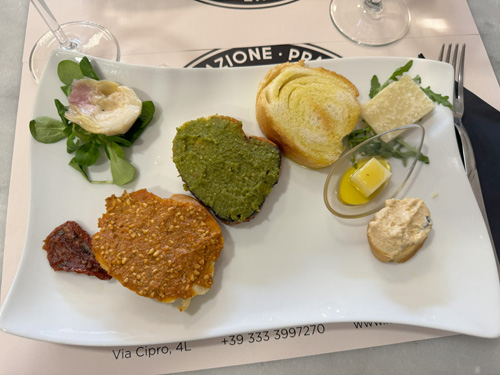
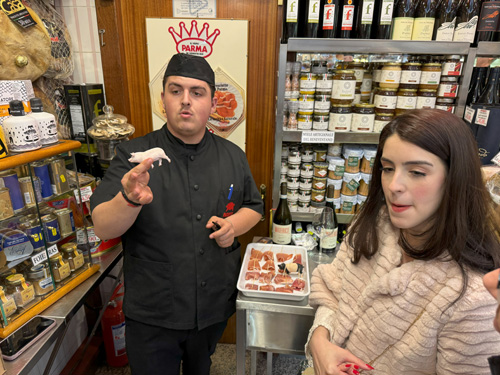
Sunday, April 21 — to Venice
We got an early ride to the airport for a 55-minute ITA (nèe Alitalia) flight to Venice. We had breakfast at a huge Eataly outlet, an American company I find rather ironic in Italy itself. The flight oddly tracked the west coast for quite a while and we were able to see what looked like the Leaning Tower of Pisa. We got a car service to take us from VCE to the Venice Maritime Terminal. At one time, lots of giant cruise ships used this terminal, but the city is cutting back to preserve the lagoon and only smaller ships like Viking can use it now. Once we checked in, we had to take a 30-minute bus ride to the ship, Viking Jupiter, which is docked in a commercial port at Fusina on the other side of the lagoon.
Although we have cruised many times, this is our first experience with Viking. The ship carries 930 guests, so it’s more compact than many mega ships sailing today. The decor is very Scandinavian, sleek, modern, but understated. The cabin is very comfortable, well-fitted, and completely quiet. The staff is super competent and very friendly. There are many lounges and libraries and a very nice pool deck, lots of open spaces that never feel crowded, but no casino, bingo, game shows, cooking demos, art auctions, climbing walls, water slides, etc. (There is a small gym, a spa, and a couple of swimming pools, but we’re too lazy to deal with them, and in the latter case, the weather was never hot enough for swimming. In fact, the retractable roof over the pool was never opened.)

Entertainment is modest with small groups of talented folks, like four singers, a small band, a guitarist, a pianist, and a piano and violin duo, performing in the atrium and other public places. There are daily port talks and enrichment lectures, also available on the cabin TV. We had on board a resident astronomer and a historian giving mostly daily talks. Pretty decent Wi-Fi on multiple devices is free. Wines of modest quality and beers and soft drinks are served freely at lunch and dinner. Two specialty restaurants are a bit difficult to reserve (unless you have booked a higher-end cabin or suite) but are also free. Each port has one free shore excursion, usually a walking tour, and many others are offered at somewhat reasonable prices. The included tour is usually a two to four hour guided walk through the city center or a bus or boat around the highlights, whereas the extra cost tours avoid those highlights and take you to national parks, more remote areas, and neighboring villages. They include things like watching olive oil production, lunch or snacks with a “local family,” or athletic endeavors.
Although we booked a 14-day cruise, Viking actually considered this two 7-dayers and while we embarked, there were passengers already on board who started segments in Barcelona (28 days total) or Rome (21); some will get off in Athens before we do. The only reason to mention this is that Viking’s paperwork and internet interfaces are not always cognizant of what will be happening next week. The passenger mix is pretty old, 90%+ Boomers. Although Viking ads show handsome CEO types with their trophy wives, like George Clooney and his wife, the reality is much more like Fred and Ethel Mertz. I’d say the majority of the passengers are American, but there are a lot of Aussies on board and a smaller number of Brits.
One general note that I will not detail much further: My cold that I developed in Normandy came back after a brief respite and Nancy got something very similar, so we both spent the next two weeks coughing frequently and searching local pharmacies for cough medicine. Usually on cruises we dine at large tables to meet other couples, but we weren’t able to do that this time.
It wasn’t logistically feasible to do anything in Venice this afternoon, so we lunched, explored the ship, and attended a port talk in the theater. We had dinner in one of two specialty restaurants, Manfredi’s Italian, which was an excellent four-course traditional Italian meal. (I’m not going to give detailed listings of the many meals we will have on board, but they were uniformly excellent.)
Monday, April 22 — Venice
The weather, which has been great so far, turned nasty—windy and cold with scattered rain. We took an extra-cost walking tour of “Hidden Venice.” (The gratis included tour covered only St. Mark’s Square.) We loaded up into a few ferry boats and sailed at a very slow pace to a pier on the Grand Canal. Our guide was a very knowledgeable lady who took us through some narrow streets and alleyways, telling us about history and modern life in Venice. The central city has 49,000 residents but 30 million annual visitors, which means it is now 90% dependent on tourism. Nancy and I first visited Venice in the late 70s, and parts of the city have changed quite a bit with the addition of many high-end shops. Some of our fellow passengers were amused or appalled by the Venetian company employing our guides, TrumpyTours. :-)
Our walk focused mostly on atmospherics, but we did pass near some interesting sites. The Arsenale, a former naval yard, had impressive lion statues that were looted from Egypt. The Campo Santa Maria Formosa square had five-star hotels hidden behind historic facades. Our guide said that many houses in town are now AirBnBs. We found the site of Marco Polo’s house (which was replaced by a new building after a fire). We admired the tall Rialto Bridge, which crosses the wide Grand Canal, and watched the daily life passing by in gondolas, water taxis, and tons of small commercial crafts. Nearby is a very busy area with many tony shops and cafes. We were turned loose here and did some shopping. I got a really delicious gelato at the supposedly best place in Venice, SuSo’s. (This serving in California would have cost $5-7, but here it was only €2.5.) On our walk back to the ferry, we stopped briefly at St. Mark’s Square, which was jammed. Fortunately, all our time walking around town was dry, and heavy rain waited until we got back on the ship.
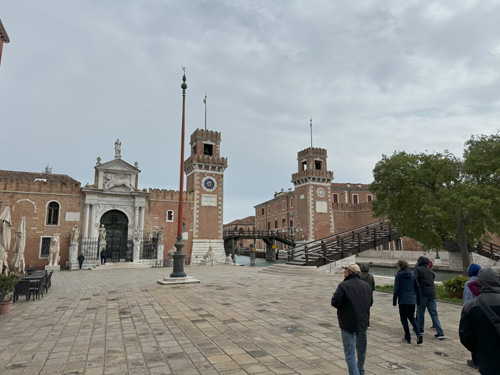
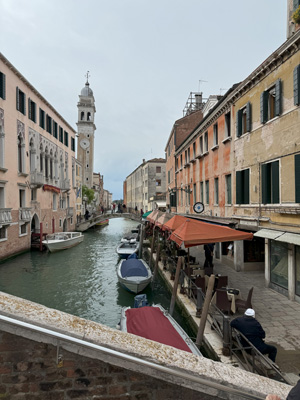
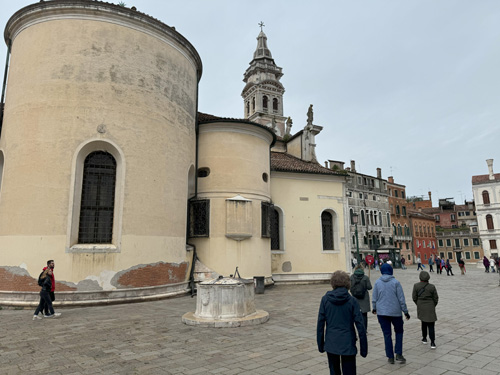
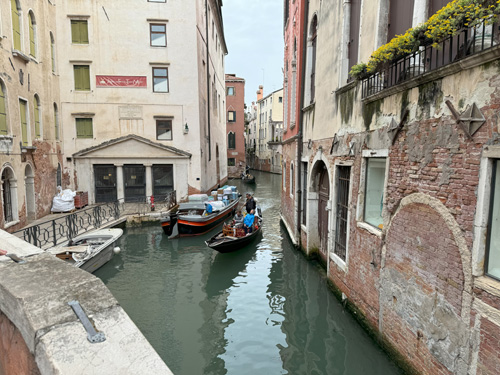
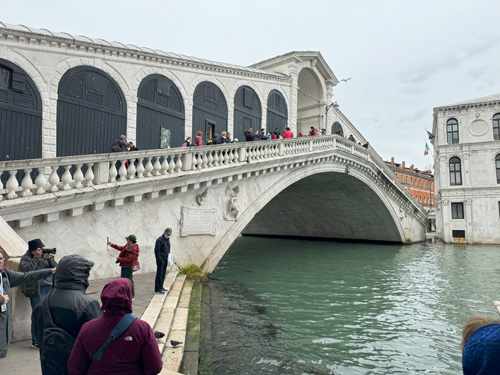
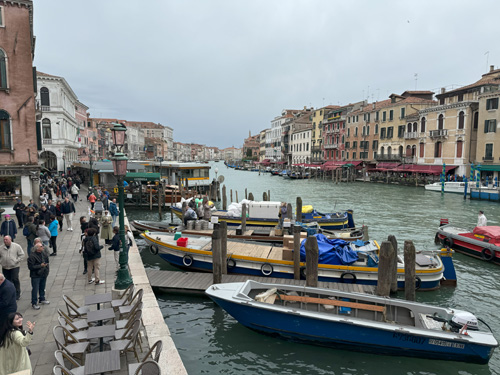
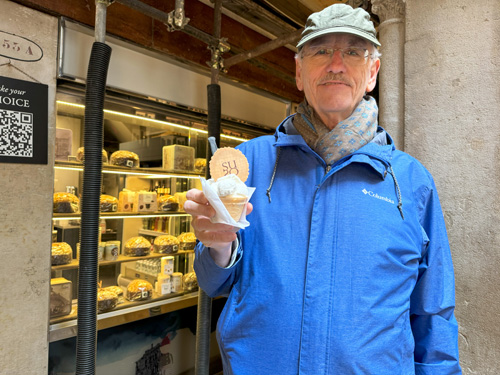
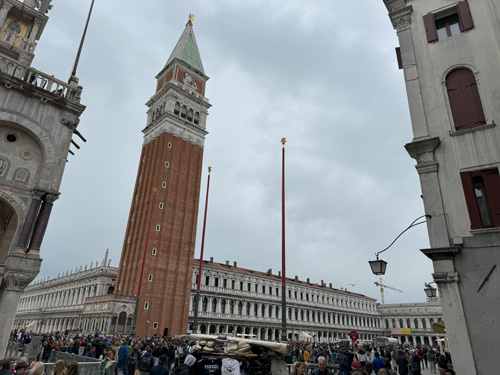
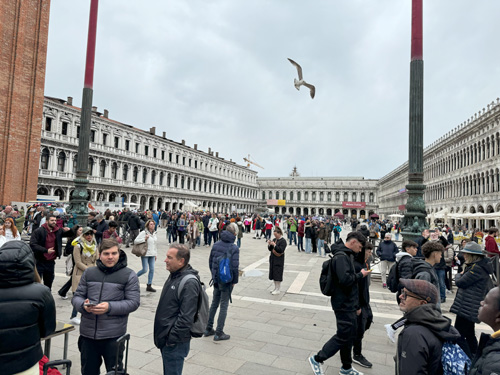
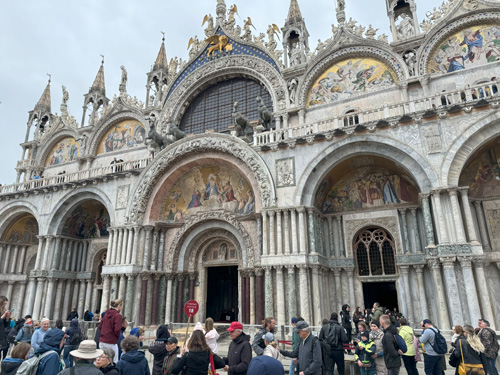
The ship left at 2 pm, so we really didn’t see much of Venice, but with the rain and the distance to downtown, we probably wouldn’t have gone back out anyway. Seas were moderately rough as we sailed east to the Dalmatian coast, but we were all comfortable. Dinner in the Restaurant (aka main dining room) was excellent. There was a show with four British singers doing highlights of American country music (somehow including Simon and Garfunkel alongside Dolly Parton and Johnny Cash) that was mildly entertaining.
Tuesday, April 23 — Split, Croatia
After a stormy night we arrived to calm seas and brilliant sunshine. Split is a very attractive port town. The harbor was packed with giant ferries. This is our first visit to the former Yugoslavia. We took the included walking tour. Our guide, Rada, was very knowledgeable and well-spoken. The biggest draw in town is Diocletian’s Palace, an immense fortress and retirement home for the Roman emperor, built late in the third century. At about 9.5 acres, it covers half of old-town Split. Most of it was turned into housing in the Middle Ages, so its interior is similar to Venice with lots of narrow streets. We visited the basement where archeological digs have removed centuries of trash and excrement and shown the Roman construction techniques. Rada described how travertine, used in the ceilings, is created by calcium carbonate silting in local rivers and waterfalls. The Game of Thrones TV series filmed here for two years, seasons 3 and 4, completely occupying the downtown and leaving a few GoT souvenir shops in their wake.

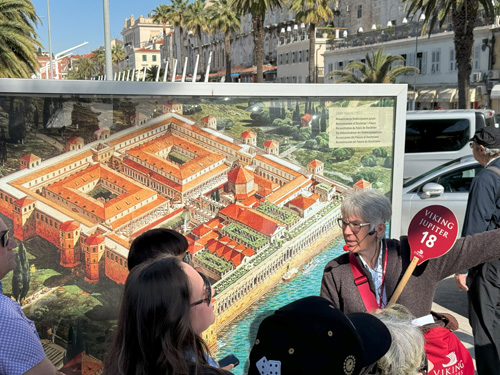
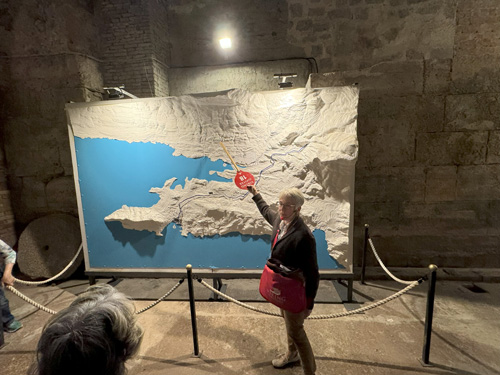
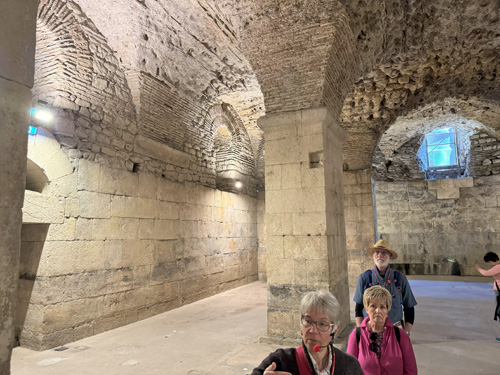
We walked through the peristyle, where Diocletian’s mausoleum still stands as part of the Cathedral of St. Domnius, which was added in the 7th century. Outside the north wall of the palace (all of the walls are mostly still there, although some housing and shops have been grafted on) is an impressively looming 8.5 m statue of Grgur Ninski (Gregory of Nin), a 10th century catholic bishop who defied the pope and conducted services in the Croatian language. The rest of the tour was navigating narrow passageways now filled with modern shops, and walking on the beautiful port promenade, lined with restaurants. Rada told us about local weather, crafts, and historical/political issues related to the breakup of Yugoslavia.
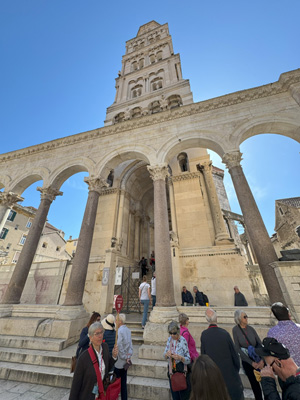
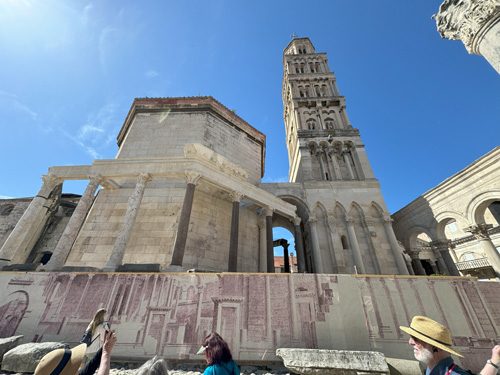

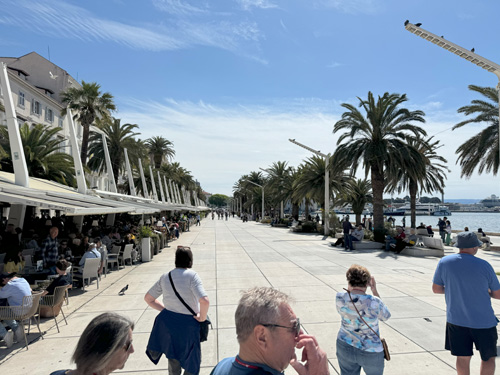
We walked back to the ship and enjoyed lunch and afternoon relaxation around the pool deck. Dinner was at the other specialty restaurant, Chef’s Table. This was an excellent meal focused on Spice Road flavors, with wines accompanying each of four courses. The 9 pm show was assistant cruise director Hazel performing a one-woman show about her life as a diva and single mother.
Wednesday, April 24 — Dubrovnik, Croatia
We were warned about rain and wind lasting all day, but it was cool and dry at least until late afternoon. Good news because Dubrovnik has lots of uneven stone staircases that would be rather treacherous when wet. We took the included walking tour of the old town and our guide Marko was outstanding—very humorous and knowledgeable. On the shuttle bus he gave us a concise history of Dubrovnik, which was once a separate city-state called Ragusa. We started with views of Fort Bokar and Fort Lovrijenac (St. Lawrence, “Dubrovnik’s Gibraltar”) and the waterfront. We entered the old town through the two Pile (pee-lay) Gates and found the first of 23 statues of St. Blaise, the city’s patron; Marko made it a game for us to find subsequent ones and we eventually saw about eight.
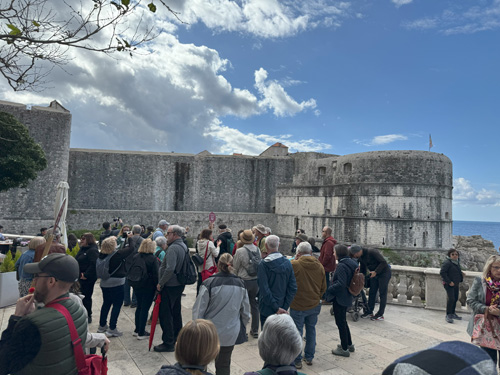
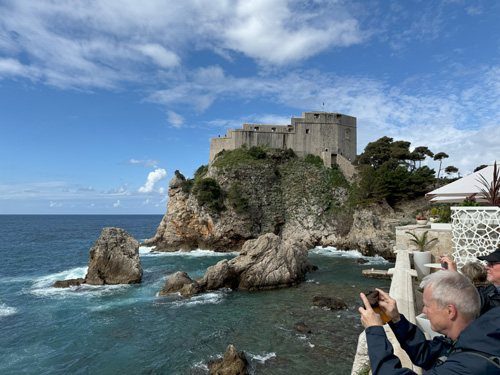
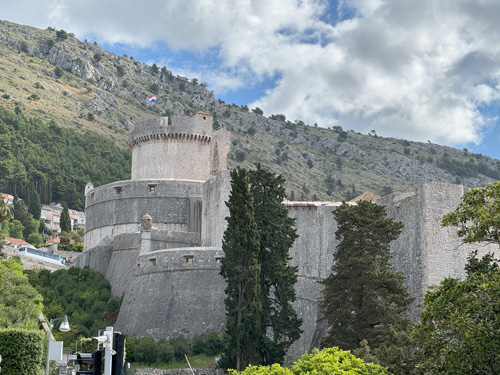

We passed by St. Saviour, a small votive church built in 1520, and which somehow survived the big earthquake of 1667. Shrapnel damage from the general city bombardment in 1991 is quite visible on the church. Walking down the wide main pedestrian street, Stradun, which originally was a canal, Marko pointed out the street he lives on, up a very steep hill reached by many dozen of stone steps. We passed by a similar street that was the Jewish ghetto; only about fifty Sephardic Jews remain in town. (The old town itself has only about one thousand residents.) We walked up to the Jesuit Stairs and found that this was the end of the Street of Shame from Game of Thrones (but more on this later).
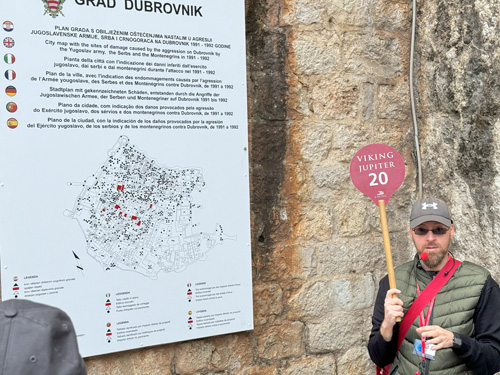
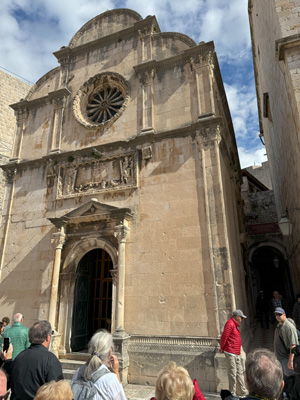
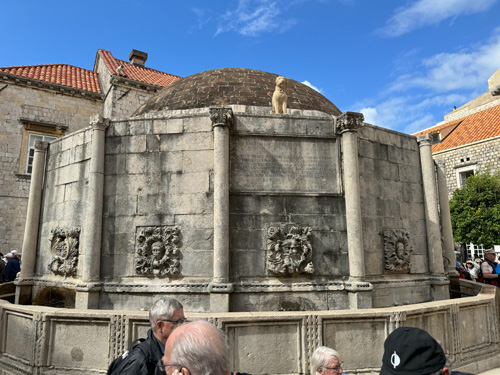
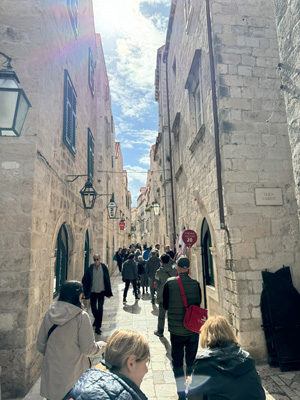
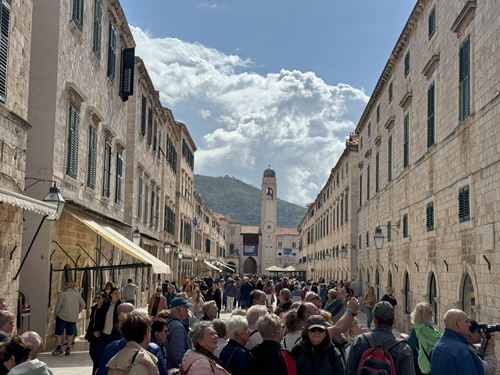
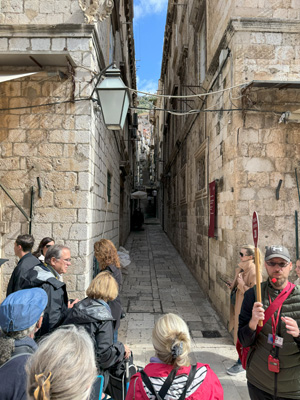
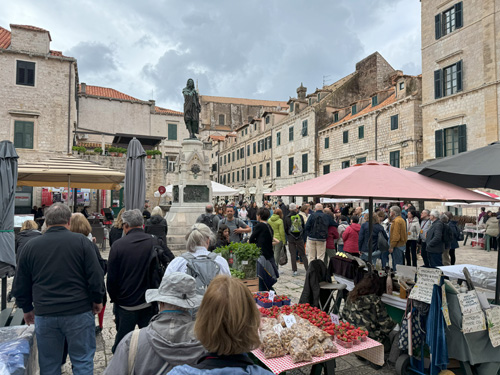
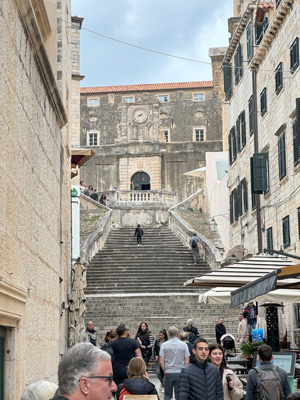

At the Dominican monastery there is an art museum. Nancy continued with the group through heavy crowds, and then the group had a half hour of free time before returning to the ship via a shuttle bus. I broke off to attend a tour I booked separately from the cruise, dedicated to Game of Thrones. I was a big fan, but Nancy wasn’t interested. The show filmed parts of seasons 2–8 here; season 1 was in Malta, but they were kicked out after damaging some local landmarks. Our guide was a lovely young woman named Ivana, who was very knowledgeable and friendly, and who showed us photos of scenes that matched up with locations we visited.
We started in Fort Lovrijenac overlooking the harbor, which hosted a variety of interior shots of the Red Keep, the giant castle of imaginary King’s Landing. Accessing it is via dozens of very steep stone steps with few bannisters. Once at the top, after serious huffing and puffing, there are fantastic views of Dubrovnik’s impressive fortress walls. We could see nearby Lokrum, the island that was used for filming the Essos city of Qarth. A large round fortress on the city walls was used to film the House of the Undying scenes in Qarth. Fort Bokar on the city walls was used for scenes with Tyrion and Varys before the Battle of Blackwater Bay, and it was easily apparent where CGI was used to add the Red Keep castle just up the hill. Also in view was Gradac Park, which was used to film the Purple Wedding (where King Joffrey was poisoned after marrying Margaery Tyrell).


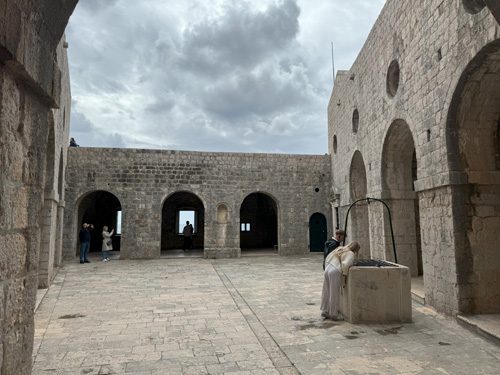
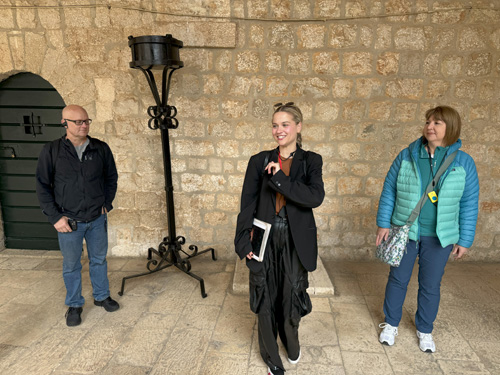
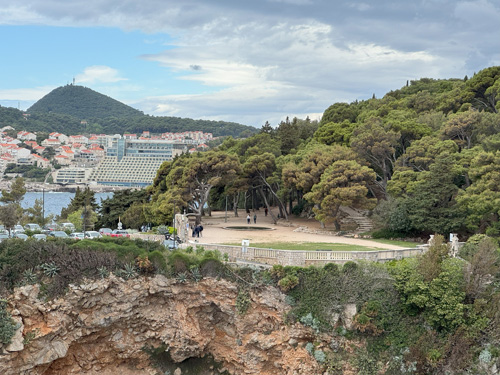
We visited the very recognizable cove and pier used for Blackwater Bay, including various scenes with Cirsei, Shane, Sansa, Tyrion, Davis, Jaime, and Myrcella. It was also in the final goodbye scene of the series, which Ivana said was somehow kept a complete secret from residents, who usually knew exactly where all the cast members were appearing, but this time did not know which characters would survive. Then we walked to the small switchback between the inner and outer Pile Gates, which was used for the big riot scene where Joffrey’s procession was attacked in a riot. Ivana told a few interesting stories about how residents were selected as extras and how they were all yelling at the Lannisters in Croatian, later mostly dubbed into English.
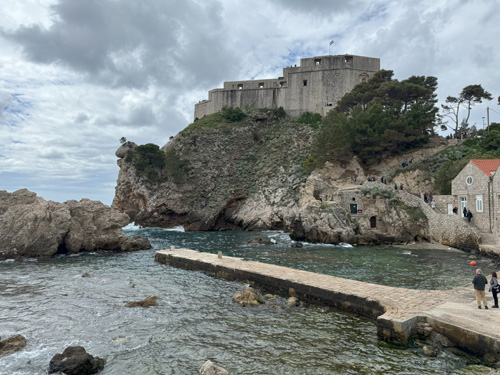
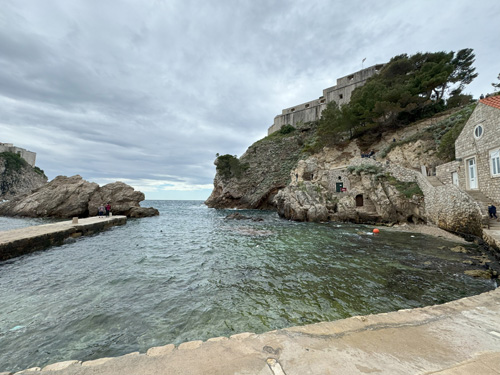
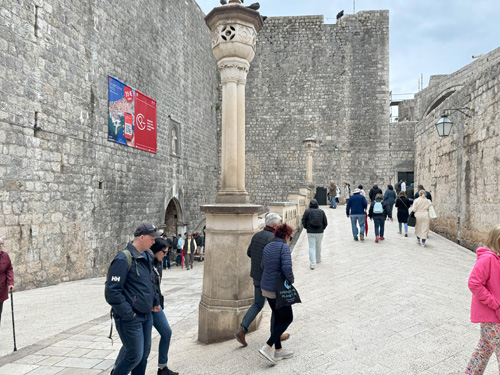
Our final stop was back to the Street of Shame and Ivana told us how the seven-day shooting was handled, including about the Irish actress Rebecca van Cleave who was Lena Headey’s nude body double. (Lena may have been willing to march down the street naked, but she had numerous tattoos and was pregnant at the time.) She said that the street is currently home to a variety of commercial shame items, such as shame burgers and shame salads. In the show, the Red Keep was CGIed in at the top of the hill where the current cable car lives, a total geographic inconsistency.
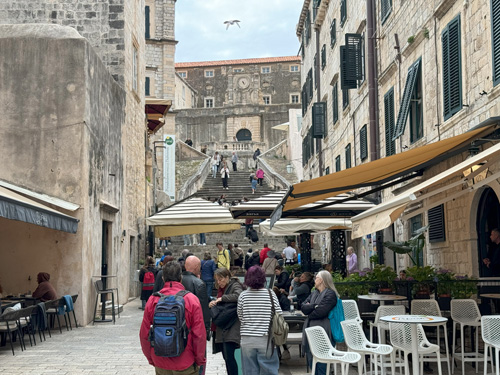
Ivana pointed out a portrait of “Johny the Boss,” the local stray cat who “owns” the street and has an Instagram account. This street was also used for the procession to Tywin Lannister’s funeral. I had the opportunity to visit a local “official” GoT gift store (Ivana said that none of the “official” stores are actually tied to the HBO show) and get my complimentary photo taken on an Iron Throne, but I didn’t feel I was properly dressed for it. All in all a very enjoyable extra tour.
A late lunch back on the ship and then dinner in the Restaurant. The evening entertainment was a local folkloric group performing Klapa Karaka music and dancing, but we skipped it.
Thursday, April 25 — Kotor, Montenegro
The weather is beautiful today, but Nancy is laid up in bed with dizziness, nausea, and diarrhea. So I had to tour Kotor alone, on the included town walk. The small city at the very southern tip of Croatia is very compact at the end of a fjord, surrounded by steep mountains. (I think they are misusing the term fjord, which implies glacial origin.) Our guide Rada told us about the two-thousand-year history here, including a number of significant earthquakes, which always occur in April as winter ice thaws. Our first stop was St. Tryphon’s Cathedral, a church built in 1166, but it included six Greek columns from the sixth century, which survived all the earthquakes. Looking up the mountain we could pick out a fortress that was the original site of the town. There is a cable car that goes to the top, but it wasn’t open today; the views should be pretty spectacular.
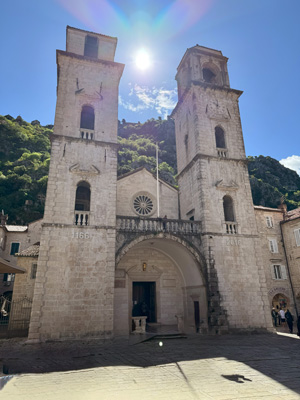
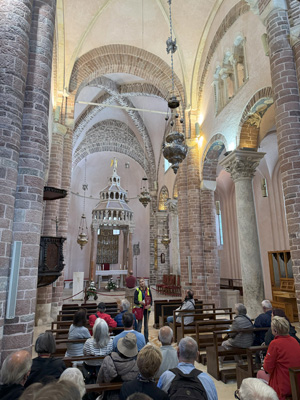
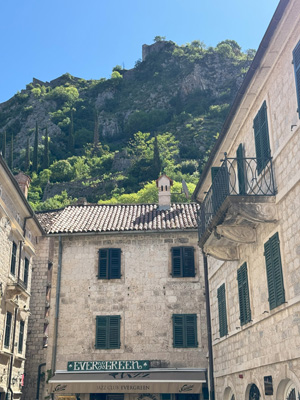
We spent some time in the crowded maritime museum, in an 18th century building, which is moderately interesting. Rada showed us a relief map that illustrated the circuitous route of bays and channels our ship had to take to reach this point. (Our cruise director had urged us to get up at 5:30 to watch our approach, but we slept in.) He also pointed out an area with radioactive mud, where Marshall Tito went for cancer treatments, and tunnels that housed submarines (U-boats, I presume). Finally we stopped at the door to St. Mary of the River (Collegiate) church, built in 1221, which has a series of bronze reliefs depicting the life of a young girl, Osanna, who saw Jesus in the mountains and then found herself a religious life healing the sick.
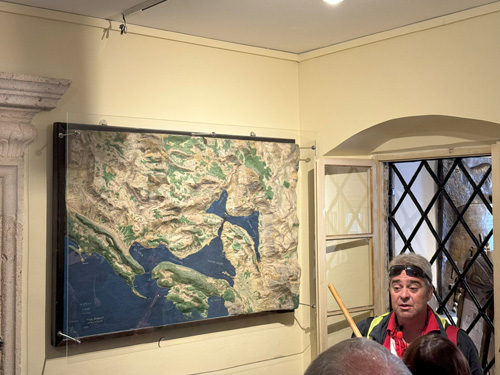
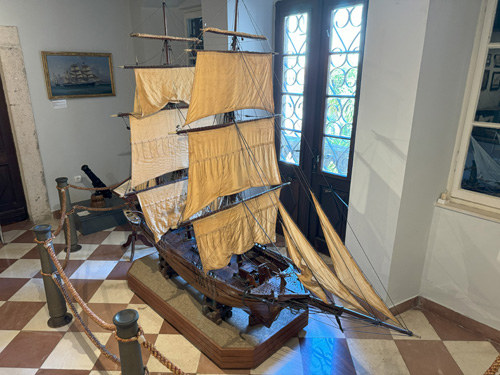
The tour was brief and when it broke up I walked along the impressive city walls, visited the cat park—the city has a lot of feral but friendly cats roaming around—and had a good gelato at Moritz Eis. Nancy started recovering slowly by afternoon, but can’t eat anything, and in fact it took her a week before her appetite really returned. She suspects it is norovirus. The ship departed at 3:30 and we had a nice time watching the close-in scenery pass by our balcony for over 90 minutes. It really looked like Norwegian fjords, although there are a lot more towns at water’s edge, huddled beneath tall, steep mountains, than we saw in Norway. A remarkable thing about this Viking ship is how quiet its engines are. If the balcony curtains were closed, you’d never know you were moving. As we turned south into the open Adriatic, we kept pretty close to shore of Albania as well, at least until after sunset.
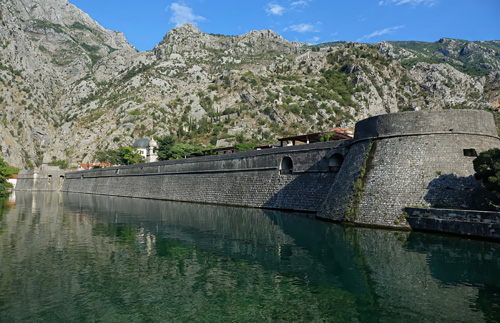
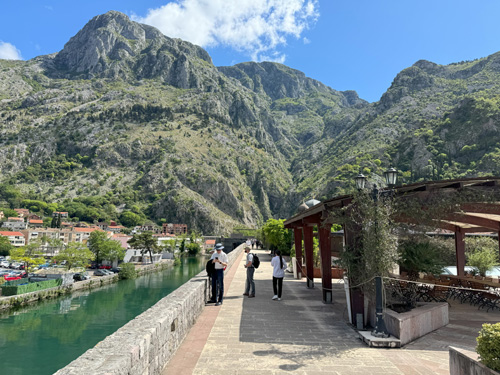
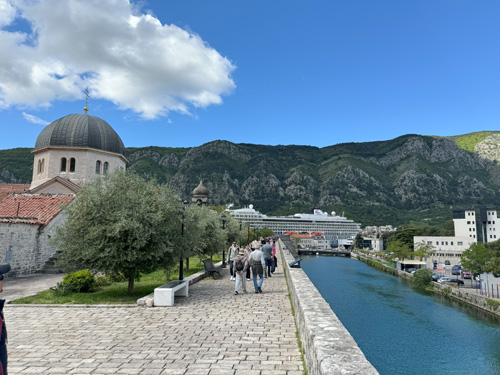

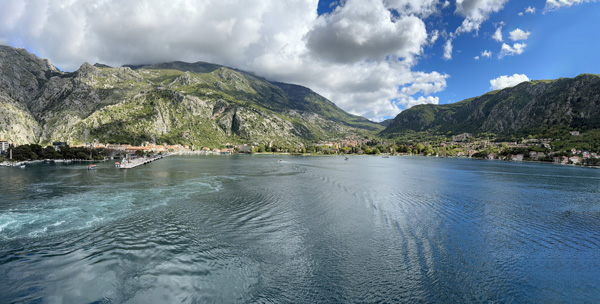
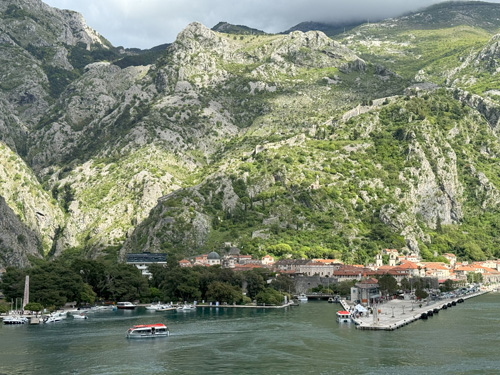
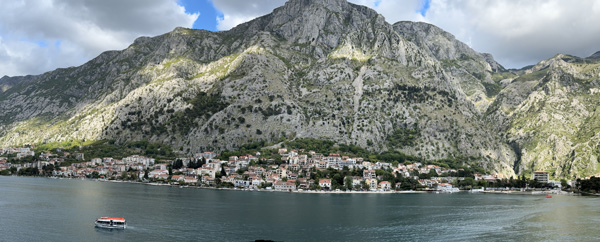

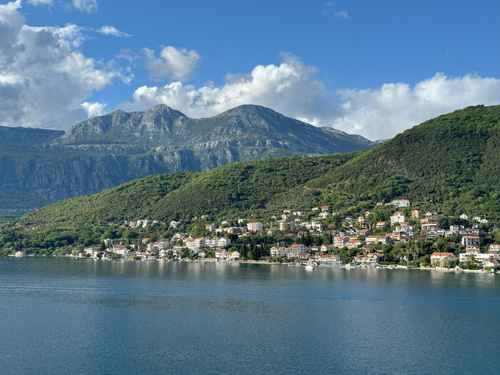
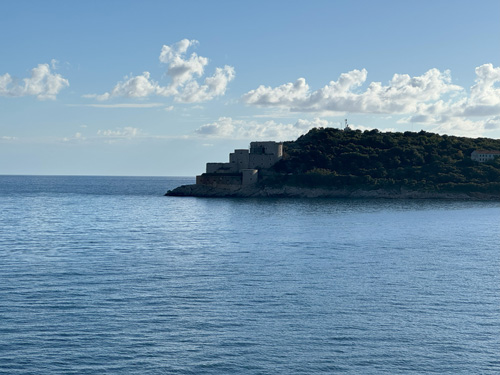
Dinner (for Hal) was barbecue on the pool deck. The entertainment tonight was a video of Mozart’s Magic Flute opera, but health concerns dictated that we not attend. We have to set our clocks ahead an hour to Eastern European Daylight Time (California +10).
Friday, April 26 — Corfu, Greece
We crossed from the Adriatic to the Ionian Sea this morning and docked in Corfu (Kérkiya), the northernmost of the Greek Ionian islands. Nancy seems fully recovered so we both had breakfast and took the included excursion. We boarded buses and drove to the Kanoni Peninsula where we saw a great view and the antique French cannon that gives the locale its name. We saw Mouse Island off in the distance, named for reasons unknown to our guide Vivi. Corfu looks different from our previous stops—lots of green, no mountains, and the visible influence of the Venetians, including some of the language. It’s a lot more modern, except for the small old town. We passed by the estate where the late Prince Philip (Queen Elizabeth’s husband) was born into the Greek nobility. The narrow roads are quite busy with the buses of three cruise ships in port today.
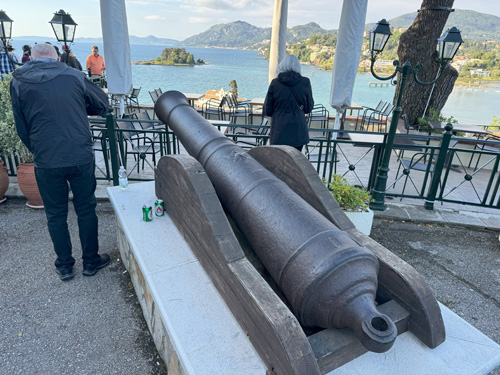
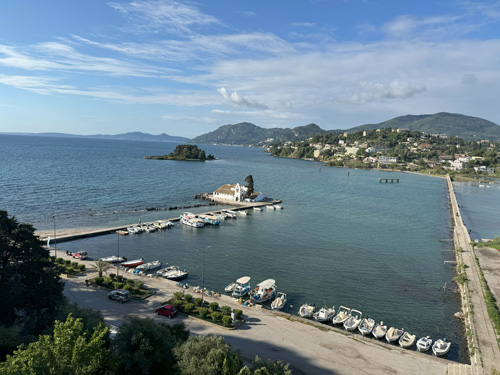
We stopped along the waterfront for a view of the old fortress, which was used from the 6th to the 16th century, and was the original town center. It was impregnable, withstanding multiple sieges, including the final one by the Ottoman Turks. We left the bus at a large park called Esplanada and walked into the old town, passing by an impressive palace that housed the British High Commissioner during the empire’s 50 year occupation. And we saw the tall spire of the Church of St. Spyridon, the patron saint of the town. From there we walked by a lot of shops, to the waterfront, and about a mile and a half back to the ship, lured in by Vivi’s bogus claim that it would be a 20-minute walk.
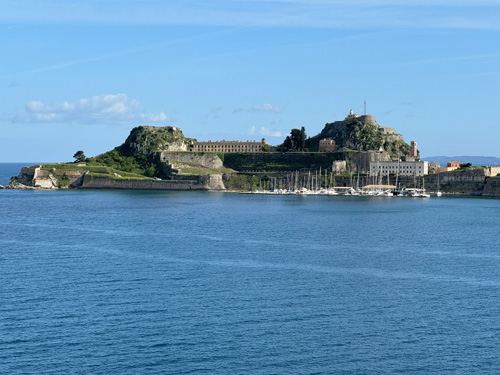

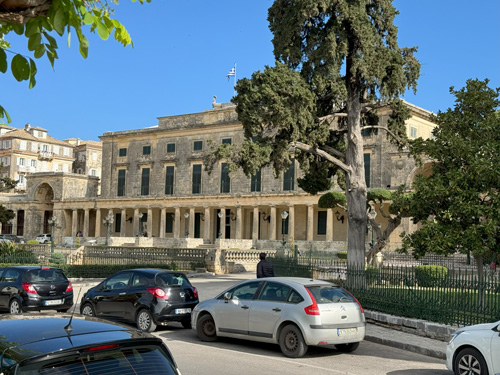
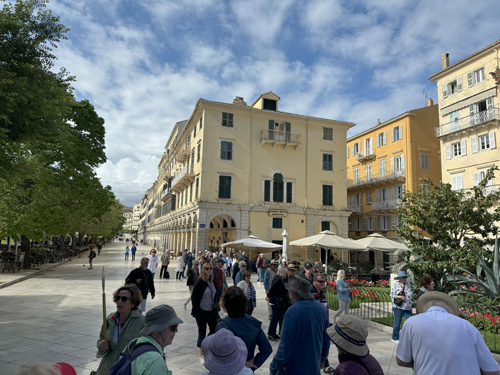
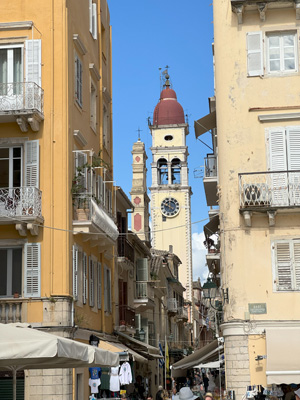
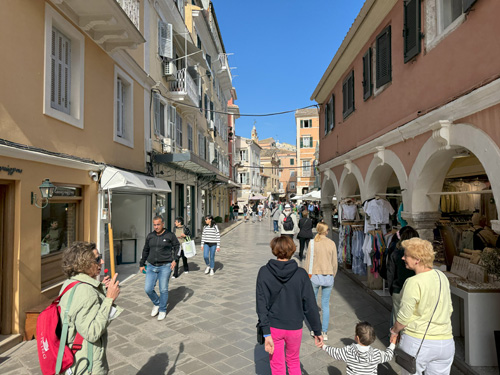
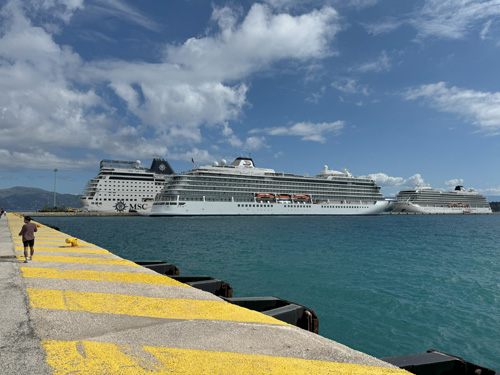
We ate lunch in Mamsen’s, a tiny counter in a nice lounge that offers Scandinavian food such as Danish Smørbrød open-face sandwiches and I had an unusual Norwegian hotdog (Pølse med lompe) that came with lots of toppings on a tortilla. We talked with the onboard cruise consultant and found that there are significant benefits to booking future cruises here, so we selected a Western Mediterranean journey in March 2026, round trip from Barcelona. Dinner was back at the Chef’s Table, where we enjoyed a dinner of Korean food. The evening entertainment was a one-man singing and dancing show by cruise director Richard Green.
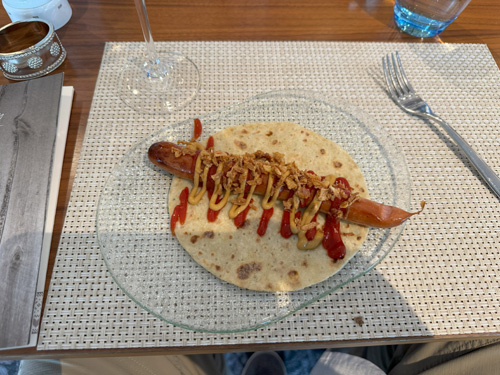
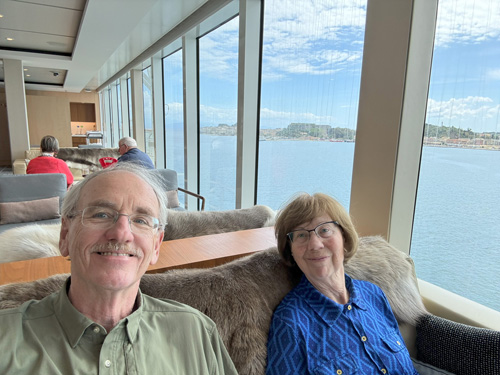

Saturday, April 27 — Katakolon and Olympia, Greece
Another beautiful day as we dock on the Peloponnese Peninsula at the small town of Katakolon (Ka-TAK-o-lon). We tried Mamsen’s again for breakfast and it was excellent, although the selection of items was dwarfed by the regular buffet. One highlight was a favorite pastry of mine, the Skolebrød, or school bread, a bun with custard and coconut icing. Our included excursion started with a 40-minute bus ride to the archaeological site of Olympia, site of the historic Olympic Games starting in 776 BC. It’s about 100 acres and operated for about 1200 years until it was razed by an earthquake and subsequently buried under 6 m of dirt. French archaeologists discovered the location in the 18th century and their German colleagues excavated it in a 100-year project that is still ongoing. The ruins are just foundations and pieces such as parts of columns and pedestals for missing statues, but a few columns are being reconstructed.
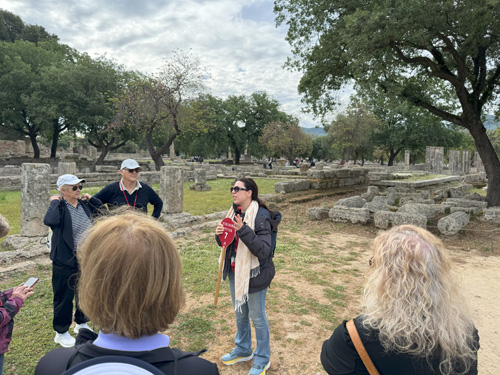
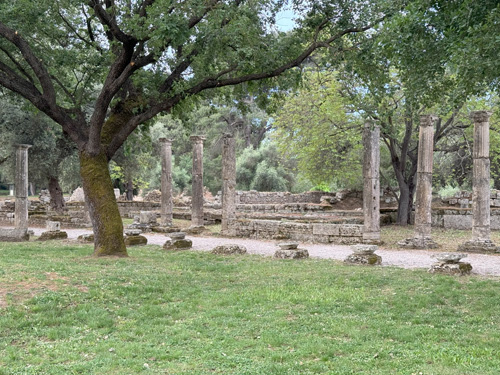
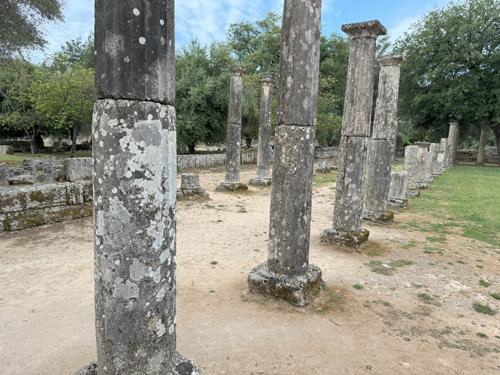
We were guided through the second-century BC gymnasium (a term that derives from the Greek word for naked, which is how the all-male athletes competed) and the Palaestra (a school where pancratium, “any method,” wrestling/boxing like modern MMA was taught). Then the remains of the Temple of Zeus from the fifth century BC, where there is a single reconstructed column 11 m high. There was originally a 13 m gold and ivory statue of Zeus inside, sculpted by Pheidias, one of the Seven Wonders of the Ancient World, but Emperor Constantine took it and it was destroyed in Constantinople.
We walked through the Olympic stadium where 50,000 spectators watched the games. The marble starting/finish line is still there. Then the Altar of Hera, where just recently the famous Olympic Torch was fired up by sunlight from a parabolic mirror and carried all over Greece to Athens, where is was turned over yesterday to the French for its journey to Paris this summer. The Philippeon, a memorial to Philip of Macedonia built by his son, Alexander the Great, has three columns standing.
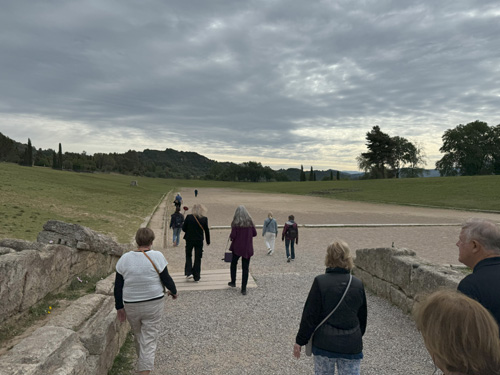
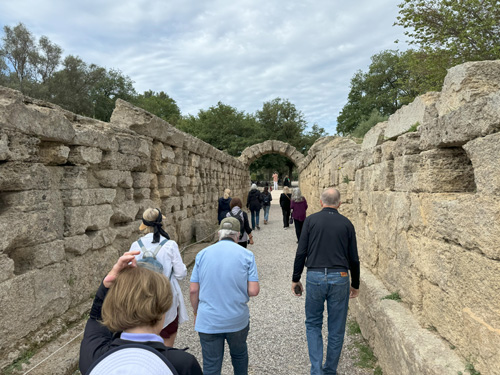
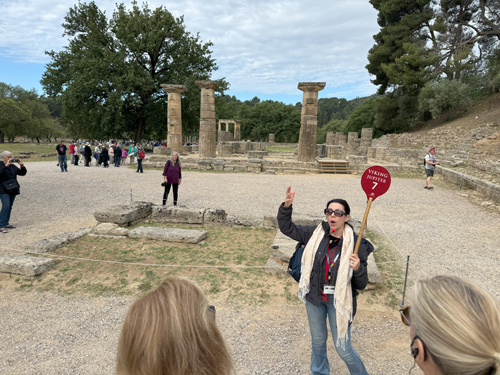

We had an hour of free time and opted to visit the archaeological museum, which has some beautiful statuary and artifacts found in the excavation. Among many dozens of major pieces is a large statue of Nike, a mostly intact statue of Emperor Hadrian, and all of the elaborate statues from the pediments of Zeus’s temple. Back on the ship we set sail at 1 pm, headed to the Aegean Sea and Piraeus (Athens). We had a relaxing afternoon reading in the Explorer’s Lounge. The evening was a farewell reception of sorts with the ship’s officers, followed by a good show of the ABBA Songbook.
